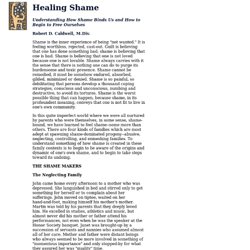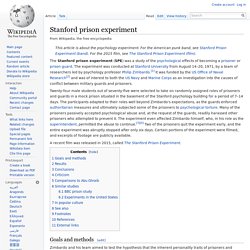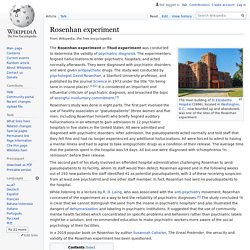

Healing Shame. Understanding How Shame Binds Us and How to Begin to Free Ourselves Robert D.

Caldwell, M.Div. Shame is the inner experience of being "not wanted. " It is feeling worthless, rejected, cast-out. Guilt is believing that one has done something bad; shame is believing that one is bad. In this quite imperfect world where we were all nurtured by parents who were themselves, in some sense, shame-bound, we have learned to feel shame--some more than others. The Neglecting Family John came home every afternoon to a mother who was depressed. In these households each person had infrequent clues that he or she was valued or even existed. The Controlling Family This is the family which is ruled by decree. The controlling family carries deep shame. The Enmeshed Family This is the family with fuzzy, haphazard, or permeable boundaries. 10 Brilliant Social Psychology Studies.
Ten of the most influential social psychology experiments.

“I have been primarily interested in how and why ordinary people do unusual things, things that seem alien to their natures.Why do good people sometimes act evil? Why do smart people sometimes do dumb or irrational things?” –Philip Zimbardo Like eminent social psychologist Professor Philip Zimbardo (author of The Lucifer Effect: Understanding How Good People Turn Evil), I’m also obsessed with why we do dumb or irrational things. The answer quite often is because of other people – something social psychologists have comprehensively shown.
Over the past few months I’ve been describing 10 of the most influential social psychology experiments. Each one tells a unique, insightful story relevant to all our lives, every day. 1. Social Psychology Basics. Social Psychology Basics. Stanford prison experiment. The Stanford prison experiment (SPE) was a study of the psychological effects of becoming a prisoner or prison guard.

The experiment was conducted at Stanford University from August 14–20, 1971, by a team of researchers led by psychology professor Philip Zimbardo.[1] It was funded by the US Office of Naval Research[2] and was of interest to both the US Navy and Marine Corps as an investigation into the causes of conflict between military guards and prisoners. Goals and methods[edit] Zimbardo and his team aimed to test the hypothesis that the inherent personality traits of prisoners and guards are the chief cause of abusive behavior in prison. Participants were recruited and told they would participate in a two-week prison simulation. Rosenhan experiment. Experiment to determine the validity of psychiatric diagnosis Rosenhan's study was done in eight parts.

The first part involved the use of healthy associates or "pseudopatients" (three women and five men, including Rosenhan himself) who briefly feigned auditory hallucinations in an attempt to gain admission to 12 psychiatric hospitals in five states in the United States. All were admitted and diagnosed with psychiatric disorders. After admission, the pseudopatients acted normally and told staff that they felt fine and had no longer experienced any additional hallucinations. All were forced to admit to having a mental illness and had to agree to take antipsychotic drugs as a condition of their release. The second part of his study involved an offended hospital administration challenging Rosenhan to send pseudopatients to its facility, whom its staff would then detect. While listening to a lecture by R. The Psychologist Archive 2013. True-believer syndrome. Dunning–Kruger effect. Cognitive bias about one's own skill The Dunning–Kruger effect is a hypothetical cognitive bias stating that people with low ability at a task overestimate their own ability, and that people with high ability at a task underestimate their own ability.

As described by social psychologists David Dunning and Justin Kruger, the bias results from an internal illusion in people of low ability and from an external misperception in people of high ability; that is, "the miscalibration of the incompetent stems from an error about the self, whereas the miscalibration of the highly competent stems from an error about others".[1] It is related to the cognitive bias of illusory superiority and comes from people's inability to recognize their lack of ability.
Without the self-awareness of metacognition, people cannot objectively evaluate their level of competence. Original study[edit] Later studies[edit] Mathematical critique[edit] Paired measures[edit] Cultural differences in self-perception[edit] Anxiety Attacks Cure - Self Help Anxiety Treatment. Profile of the Sociopath. Profile of the Sociopath This website summarizes some of the common features of descriptions of the behavior of sociopaths.

Glibness and Superficial Charm Manipulative and Conning They never recognize the rights of others and see their self-serving behaviors as permissible. They appear to be charming, yet are covertly hostile and domineering, seeing their victim as merely an instrument to be used. They may dominate and humiliate their victims. Grandiose Sense of Self Feels entitled to certain things as "their right.
" Other Related Qualities: NOTE: In the 1830's this disorder was called "moral insanity. " DSM-IV Definition Antisocial personality disorder is characterized by a lack of regard for the moral or legal standards in the local culture. Diagnostic Criteria (DSM-IV) 1. 2. 3. 4. Antisocial Personality Disorder Overview (Written by Derek Wood, RN, BSN, PhD Candidate) Antisocial Personality Disorder results in what is commonly known as a Sociopath.